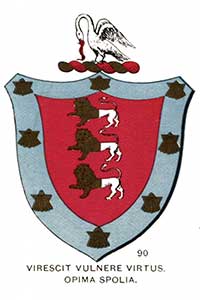The O’Meara Family

(Crest No. 90. Plate 46.)
THE O’Meara or O’Mara family is descended from Milesius, King of Spain, through the line of Heber, third son of that monarch.
The O’Mearas belonged to the Dal Cais tribe, founded by Cormac Cas, son of Olliol Ollum, King of Munster, and Sabia, daughter of Con Kead Caha, or Con of the Hundred Battles, King of Ireland in the second century, and thus are sprung from the united blood of both Heber and Heremon.
Among their maternal ancestry was Samhair, daughter of the famous warrior-bard, Ossian.
The ancient name was Meadra, signifying “Joyful.” The name was taken from Mearadhaigh, a chieftain of the sept.
The heads of this clan held possessions in the County of Tipperary, and were Chiefs of Hy Fathaidh, Hy Niall and Hy Eochaidh Finn. The O’Mearas had an extensive territory in the barony of Upper Ormond, in the above named county, and the name of their chief residence, Tuaim-ni-Meara, is still retained in the town of Toomavara, in that district.
The Hy Nialls here mentioned were of the race of Eugenius of Munster.
The O’Mearas, in conjunction with the other native families of the locality, carried on a protracted and sanguinary warfare against the Anglo-Normans, until finally overpowered. They suffered still more in person and property after the triumph of William the Third, and many of them crossed to France, where they took service in the Irish Brigade, to which they subsequently contributed many brave officers from the rank of sub-Lieutenant to that of General of Brigade.
One of these, General O’Meara, is noted for his splendid defense of Dunkirk against the English and their allies, in 1793. The Duke of York, with thirty-five thousand men, laid siege to the town, which was held by a garrison of three thousand men commanded by O'Meara. According to the admission of the English and their allies, the place was destitute of any real defense, the works being in “a most deplorable state, and the garrison totally insufficient to defend the town.” The Duke summoned O’Meara to surrender on the ground of the impossibility of defense, to which the latter replied: “I shall defend it with the brave republicans I have the honor to command.” And he did so with such vigor and success that the besieging army was held at bay until relief arrived for the garrison, when the besiegers were forced to retreat with the loss of fifty-two cannon and most of their munitions and baggage. This O’Meara previously served in Roth’s Regiment of the Irish Brigade, and was the son of a veteran Captain in Clare’s Regiment of the same body. He had four brothers, all of whom were officers in the French army. Of these, two were Colonels under Napoleon the First. One of them, Daniel O’Meara, had been an officer in Berwick’s Regiment, Irish Brigade, and the other, William, rose under the Napoleonic régime to be a General of Brigade and a Baron of the Empire. Many others of this family were honored by the French kings with the rank of Chevalier of the Order of St. Louis. Another distinguished member of this ancient family was Dr. Barry O’Meara, who accompanied Napoleon to St. Helena, and wrote one of the most valuable books extant on the life and deeds of the great Emperor.
Dermot O’Meara, a learned physician, was born in Ireland in the early part of the sixteenth century. His son, Edmund O’Meara, was also a famous physician in his day, and was a member of the College of Physicians, London. One of the latter’s sons was a learned Jesuit, and another of them was a Major in the army of King James the Second, and fell in the service of that king in the war, 1689-91. There are many of this name in the United States and the British Colonies, among whom may be mentioned Mr. Maurice O’Meara of Brooklyn, N. Y., a worthy representative of this family, and the Rev. David O’Meara of Cincinnati, Ohio, the Rev. F. O’Meara of Marysville, Cal., and the Rev. P. J. O’Meara of Piermont, N. Y.
